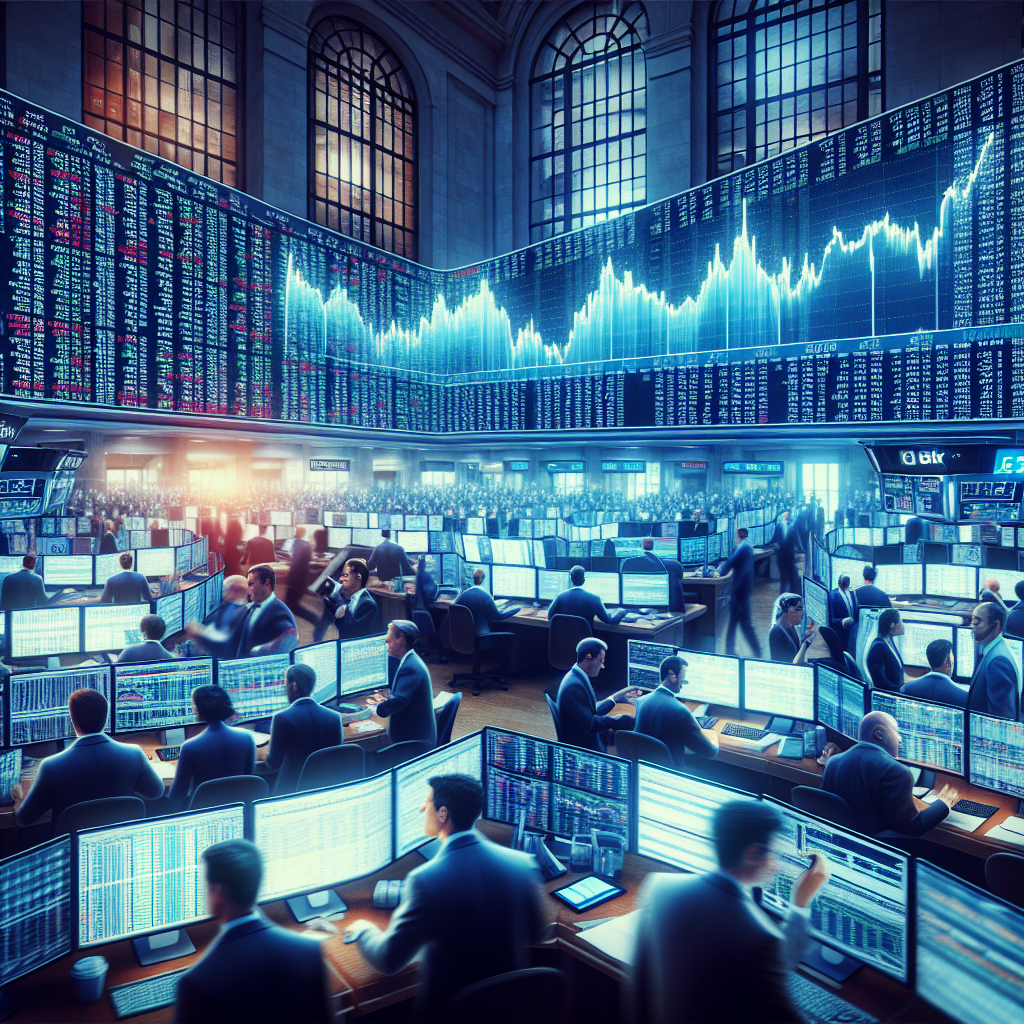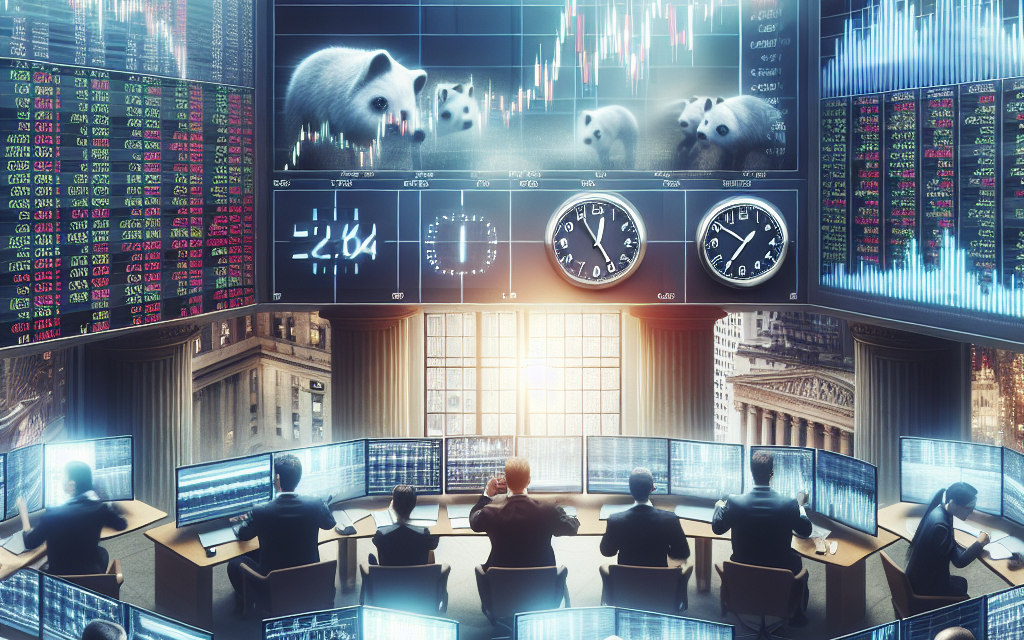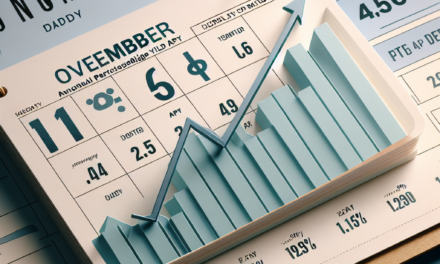“Last-Minute Rally: Wall Street’s Closing Bell Boosts Stocks”
Introduction
In a dramatic turn of events, the final hour of trading on Wall Street witnessed a significant surge in stock prices, marking a robust end to the trading session. This unexpected rally came as investors reacted to a combination of positive economic indicators, corporate earnings reports, and easing geopolitical tensions, which collectively bolstered market confidence. The late-session momentum was driven by gains across multiple sectors, with technology and financial stocks leading the charge. As the closing bell rang, major indices posted impressive gains, reflecting renewed investor optimism and setting a positive tone for the upcoming trading days.
Factors Driving The Late-Day Stock Surge On Wall Street
In the dynamic world of financial markets, the final hour of trading often holds a unique significance, as it can dramatically alter the day’s outcomes. Recently, Wall Street experienced a notable surge in stock prices during this critical period, leaving investors and analysts alike eager to understand the underlying factors driving this late-day rally. Several key elements contributed to this unexpected upswing, each playing a pivotal role in shaping the market’s trajectory.
To begin with, investor sentiment is a crucial factor that can influence market movements, particularly in the closing hours of trading. On this occasion, a wave of optimism swept through the market, fueled by positive economic data released earlier in the day. Reports indicating stronger-than-expected job growth and increased consumer spending provided a boost to investor confidence, suggesting that the economy might be more resilient than previously anticipated. This newfound optimism encouraged investors to re-enter the market, driving up stock prices as the trading day drew to a close.
In addition to positive economic indicators, corporate earnings reports also played a significant role in the late-day stock surge. Several major companies released their quarterly earnings results, which exceeded analysts’ expectations. These robust earnings reports not only reinforced the notion of a strengthening economy but also highlighted the ability of individual companies to navigate challenging market conditions successfully. As a result, investors were more inclined to invest in these companies, further propelling the upward momentum in stock prices.
Moreover, the actions of institutional investors can have a profound impact on market dynamics, particularly during the final hour of trading. Institutional investors, such as mutual funds and pension funds, often engage in end-of-day trading to adjust their portfolios based on the latest market developments. On this particular day, it appears that institutional investors were actively buying stocks, possibly in response to the positive economic data and strong corporate earnings. This influx of institutional buying added significant upward pressure on stock prices, contributing to the late-day surge.
Another factor that cannot be overlooked is the role of market algorithms and automated trading systems. These systems are designed to execute trades based on pre-set criteria and can react swiftly to changes in market conditions. As stock prices began to rise, these algorithms likely detected the upward trend and initiated additional buying, amplifying the late-day rally. The speed and efficiency of these automated systems can exacerbate market movements, leading to rapid and substantial price changes in a short period.
Furthermore, geopolitical developments and policy announcements can also influence market behavior, particularly when they occur close to the end of the trading day. On this occasion, there were no major geopolitical events or policy shifts that directly impacted the market. However, the absence of negative news can sometimes be a positive catalyst, as it allows investors to focus on the favorable economic and corporate developments at hand.
In conclusion, the late-day surge in stock prices on Wall Street was driven by a confluence of factors, including positive economic data, strong corporate earnings, institutional buying, and the influence of automated trading systems. Each of these elements contributed to a heightened sense of optimism among investors, leading to a significant upward movement in stock prices as the trading day came to a close. As always, understanding these factors is essential for investors seeking to navigate the complexities of the financial markets effectively.
Key Players In The Last-Hour Trading Rally
In the dynamic world of stock markets, the final hour of trading often holds a unique significance, as it can dramatically alter the day’s outcomes. Recently, Wall Street witnessed a remarkable surge in the last hour of trading, driven by key players who strategically maneuvered to capitalize on market conditions. This late rally not only captured the attention of investors but also underscored the influence of major market participants in shaping the day’s financial narrative.
To begin with, institutional investors played a pivotal role in the last-hour trading rally. These entities, which include mutual funds, pension funds, and insurance companies, possess substantial capital and often engage in large-scale transactions. As the trading day neared its end, many institutional investors seized the opportunity to adjust their portfolios, either by rebalancing their holdings or by taking advantage of favorable pricing. Their actions, characterized by high-volume trades, injected significant liquidity into the market, thereby contributing to the upward momentum observed in the final hour.
In addition to institutional investors, hedge funds emerged as key players in the last-hour trading rally. Known for their aggressive trading strategies and ability to swiftly respond to market fluctuations, hedge funds often engage in tactical maneuvers to maximize returns. During the last hour of trading, several hedge funds executed strategic trades, leveraging advanced algorithms and real-time data analytics to identify and exploit short-term market inefficiencies. This not only amplified the trading volume but also added a layer of complexity to the market dynamics, as hedge funds’ rapid-fire transactions influenced stock prices and investor sentiment.
Moreover, retail investors, empowered by technological advancements and easy access to trading platforms, also contributed to the last-hour surge. In recent years, the democratization of trading has enabled individual investors to participate actively in the stock market. As the trading day drew to a close, many retail investors, driven by a mix of optimism and fear of missing out, engaged in buying activities. Their collective actions, though smaller in scale compared to institutional and hedge fund trades, nonetheless played a crucial role in sustaining the upward trajectory of stock prices.
Furthermore, the role of market makers cannot be overlooked in the context of the last-hour trading rally. These entities, responsible for providing liquidity and ensuring smooth market operations, actively participated in the final hour by facilitating trades and maintaining orderly markets. By adjusting their bid-ask spreads and executing trades on behalf of clients, market makers helped stabilize the market and prevent excessive volatility, thereby supporting the overall upward movement.
In conclusion, the last-hour trading rally on Wall Street was a multifaceted event, driven by the concerted efforts of various key players. Institutional investors, hedge funds, retail investors, and market makers each played distinct yet interconnected roles in shaping the market’s trajectory. Their actions, influenced by a combination of strategic objectives and market conditions, underscored the complexity and dynamism of the stock market. As investors continue to navigate the ever-evolving financial landscape, understanding the interplay between these key players remains essential for making informed investment decisions. The recent surge serves as a reminder of the power and influence wielded by these market participants, particularly in the critical final moments of trading.
Impact Of Economic Indicators On The Market’s Final Hour
In the dynamic world of financial markets, the final hour of trading often holds significant sway over the day’s outcomes, and this was particularly evident in the recent surge of stocks on Wall Street. The last hour of trading can be a period of heightened activity, as investors react to the day’s developments and position themselves for the next trading session. On this occasion, the market’s late rally was largely influenced by a series of economic indicators that provided a clearer picture of the economic landscape, prompting investors to adjust their strategies accordingly.
Economic indicators serve as vital tools for investors, offering insights into the health and direction of the economy. In the hours leading up to the market’s close, several key indicators were released, each contributing to the overall sentiment. For instance, a report on consumer confidence showed an unexpected increase, suggesting that consumers remain optimistic about their financial prospects. This boost in consumer sentiment often translates into increased spending, which can drive corporate earnings and, consequently, stock prices higher. As investors digested this information, it became apparent that the consumer sector might be more resilient than previously thought, leading to a surge in buying activity.
Moreover, data on manufacturing output revealed a modest uptick, indicating that industrial activity is gaining momentum. This was particularly encouraging for sectors closely tied to manufacturing, such as technology and industrials, which saw notable gains in the final hour. The manufacturing data alleviated some concerns about a potential slowdown in economic growth, providing investors with a renewed sense of confidence. As a result, stocks in these sectors experienced a late rally, contributing to the overall market surge.
In addition to domestic economic indicators, global factors also played a role in shaping investor sentiment. News of easing geopolitical tensions and positive developments in international trade negotiations provided a backdrop of stability, encouraging investors to take on more risk. The interconnectedness of global markets means that such developments can have a ripple effect, influencing investor behavior across different regions. As these global factors aligned with the positive domestic indicators, the market experienced a synchronized uplift, further fueling the late-hour surge.
Furthermore, the actions of institutional investors, who often make significant trades in the final hour, amplified the market’s upward momentum. These large-scale investors, such as mutual funds and pension funds, frequently adjust their portfolios based on the latest economic data and market conditions. Their buying activity can create a cascading effect, prompting other investors to follow suit and driving stock prices higher. The combination of positive economic indicators and strategic moves by institutional investors created a perfect storm for the market’s late rally.
In conclusion, the surge in stocks during the last hour of Wall Street trading was a testament to the profound impact of economic indicators on investor behavior. As these indicators painted a more optimistic picture of the economy, investors responded by increasing their exposure to equities, leading to a significant uptick in stock prices. The interplay between domestic data, global developments, and institutional actions underscores the complexity of financial markets and the importance of staying informed. As investors continue to navigate this ever-changing landscape, the influence of economic indicators will remain a crucial factor in shaping market outcomes.
How Investor Sentiment Shifted In The Last Hour Of Trading

In the dynamic world of stock markets, the final hour of trading often holds significant sway over the day’s outcomes, and this was particularly evident in the recent surge observed on Wall Street. As the trading day unfolded, investors were initially met with a mixed bag of economic indicators and corporate earnings reports, which contributed to a cautious atmosphere. However, as the clock ticked towards the closing bell, a palpable shift in investor sentiment emerged, driving a notable upswing in stock prices.
Throughout the day, market participants grappled with a variety of factors that influenced their trading decisions. Early in the session, concerns over inflationary pressures and potential interest rate hikes by the Federal Reserve weighed heavily on investors’ minds. These apprehensions were compounded by geopolitical tensions and supply chain disruptions, which have been persistent themes in recent months. Consequently, the market exhibited a degree of volatility, with indices fluctuating as traders digested the latest developments.
Despite these challenges, the latter part of the trading day brought a wave of optimism, spurred by several key developments. Notably, a series of positive earnings reports from major corporations provided a much-needed boost to investor confidence. Companies across various sectors, including technology, healthcare, and consumer goods, reported better-than-expected quarterly results, underscoring their resilience in navigating the current economic landscape. This influx of encouraging data helped to alleviate some of the earlier concerns and set the stage for a more bullish outlook.
Moreover, the market was buoyed by comments from Federal Reserve officials, who signaled a more measured approach to monetary policy adjustments. Their reassurances that any interest rate hikes would be gradual and data-dependent helped to assuage fears of an abrupt tightening of financial conditions. This dovish stance was well-received by investors, who interpreted it as a sign that the central bank remains committed to supporting economic growth while keeping inflation in check.
As the final hour of trading approached, these positive catalysts coalesced to create a more favorable environment for equities. Investors, emboldened by the confluence of strong corporate earnings and supportive monetary policy signals, began to increase their exposure to risk assets. This shift in sentiment was reflected in the broad-based rally that ensued, with major indices such as the S&P 500 and the Dow Jones Industrial Average posting significant gains.
In addition to these macroeconomic and corporate factors, technical considerations also played a role in the late-session surge. Many traders and institutional investors closely monitor key support and resistance levels, and the breach of these thresholds can trigger a flurry of buying activity. As stocks began to break through these technical barriers, momentum-driven strategies further amplified the upward movement, contributing to the robust finish.
In conclusion, the last hour of trading on Wall Street demonstrated the intricate interplay of economic data, corporate performance, and investor psychology. While the day began with uncertainty and caution, a series of positive developments catalyzed a shift in sentiment, culminating in a strong rally. This episode underscores the importance of remaining attuned to the myriad factors that can influence market dynamics, particularly in the ever-volatile landscape of stock trading. As investors continue to navigate these complexities, the ability to adapt to changing conditions will remain a crucial determinant of success.
Sector Performance During The Late-Day Stock Surge
In the final hour of trading on Wall Street, a remarkable surge in stock prices captured the attention of investors and analysts alike. This late-day rally was not only a testament to the market’s inherent volatility but also highlighted the varying performances across different sectors. As the trading day drew to a close, the market’s upward momentum was driven by a confluence of factors, including investor sentiment, economic indicators, and sector-specific developments.
To begin with, the technology sector emerged as a significant beneficiary of the late-day surge. Tech stocks, often seen as bellwethers of market performance, experienced a notable uptick. This was largely attributed to positive earnings reports from major tech companies, which exceeded market expectations and instilled confidence among investors. Furthermore, advancements in artificial intelligence and cloud computing continued to bolster the sector’s outlook, attracting substantial capital inflows. As a result, technology stocks led the charge, contributing significantly to the overall market gains.
In contrast, the energy sector displayed a more mixed performance during the late-day rally. While some energy stocks benefited from rising oil prices, driven by geopolitical tensions and supply constraints, others faced headwinds due to concerns over regulatory changes and the transition to renewable energy sources. Despite these challenges, the sector managed to post modest gains, underscoring the complex dynamics at play. Investors remained cautiously optimistic, balancing short-term gains with long-term sustainability considerations.
Meanwhile, the financial sector also played a pivotal role in the market’s late surge. Banks and financial institutions saw their stock prices rise as interest rates showed signs of stabilizing. This development was welcomed by investors, who had been wary of the potential impact of fluctuating rates on the sector’s profitability. Additionally, robust consumer spending and a resilient labor market provided further support, enhancing the sector’s appeal. Consequently, financial stocks contributed positively to the market’s overall performance.
The healthcare sector, on the other hand, experienced a more subdued response to the late-day rally. While some pharmaceutical companies reported promising developments in drug trials, the sector as a whole faced challenges related to regulatory scrutiny and pricing pressures. Nevertheless, the defensive nature of healthcare stocks provided a degree of stability, attracting investors seeking refuge from market volatility. As such, the sector’s performance, though not as pronounced as others, remained steady.
Moreover, the consumer discretionary sector witnessed a notable boost during the late-day trading session. Retail stocks, in particular, benefited from strong consumer confidence and robust spending patterns. The anticipation of a successful holiday shopping season further fueled optimism, driving stock prices higher. This sector’s performance underscored the resilience of consumer demand, even amid broader economic uncertainties.
In summary, the late-day stock surge on Wall Street highlighted the diverse performances across various sectors. While technology and financial stocks led the rally, energy and healthcare sectors displayed more nuanced responses. The consumer discretionary sector also played a crucial role, buoyed by strong consumer sentiment. As investors navigated these sector-specific dynamics, the market’s late surge served as a reminder of the intricate interplay between economic indicators, investor sentiment, and sectoral developments. This confluence of factors ultimately shaped the market’s trajectory, offering valuable insights into the complexities of stock market behavior.
Historical Analysis Of Last-Hour Trading Surges
In the dynamic world of stock markets, the last hour of trading often holds a unique significance, frequently characterized by heightened volatility and unexpected surges. Historically, this period has been a focal point for traders and investors alike, as it can dramatically alter the day’s market narrative. Understanding the historical patterns of last-hour trading surges provides valuable insights into market behavior and investor psychology.
The phenomenon of last-hour trading surges is not a recent development. It has been observed for decades, with various factors contributing to this intriguing market behavior. One primary reason is the strategic decisions made by institutional investors. These large players often execute significant trades towards the end of the trading day to minimize market impact and to align their portfolios with daily market developments. Consequently, their actions can lead to substantial price movements, creating a ripple effect across the market.
Moreover, the last hour of trading is a critical time for traders to adjust their positions based on the day’s news and events. Throughout the trading day, investors digest a plethora of information, including economic data releases, corporate earnings reports, and geopolitical developments. As the market nears its close, traders reassess their strategies, leading to a flurry of activity that can result in sharp price swings. This behavior underscores the importance of the last hour as a period of reflection and decision-making for market participants.
In addition to institutional activity and news-driven trading, algorithmic trading has also played a significant role in last-hour surges. With the advent of sophisticated trading algorithms, many market participants now rely on automated systems to execute trades. These algorithms are often programmed to react to specific market conditions, such as price thresholds or volume spikes, which are more likely to occur as the trading day draws to a close. As a result, algorithmic trading can amplify last-hour volatility, contributing to the dramatic surges observed in the market.
Furthermore, the last hour of trading is often influenced by the need for portfolio rebalancing. Fund managers and institutional investors frequently adjust their holdings at the end of the day to meet specific investment mandates or to prepare for anticipated market conditions. This rebalancing can lead to significant buying or selling pressure, further fueling last-hour market movements. The cumulative effect of these activities can create a self-reinforcing cycle, where increased volatility attracts more traders, thereby intensifying the market’s momentum.
Historically, last-hour trading surges have also been linked to the phenomenon known as “window dressing.” This practice involves fund managers making strategic trades at the end of a reporting period to improve the appearance of their portfolios. By purchasing high-performing stocks or selling underperforming ones, managers aim to present a more favorable picture to investors. Although regulatory scrutiny has reduced the prevalence of window dressing, its impact on last-hour trading cannot be entirely discounted.
In conclusion, the last hour of trading on Wall Street is a period of heightened activity and significance, driven by a confluence of factors including institutional strategies, news-driven adjustments, algorithmic trading, and portfolio rebalancing. Understanding these historical patterns provides valuable insights into market dynamics and investor behavior. As markets continue to evolve, the last hour of trading will likely remain a critical focal point for traders and investors seeking to navigate the complexities of the financial landscape.
Strategies For Investors During Late-Day Market Volatility
In the dynamic world of stock trading, the final hour of Wall Street’s session often presents a unique set of opportunities and challenges for investors. This period, characterized by heightened volatility and rapid price movements, can be both exhilarating and daunting. Understanding the strategies that can be employed during this time is crucial for investors looking to capitalize on late-day market volatility.
One of the primary strategies investors might consider is closely monitoring market trends throughout the day. By doing so, they can identify patterns or signals that may indicate potential movements in the final hour. For instance, if a stock has been steadily gaining throughout the day, it might experience a surge as traders rush to capitalize on its momentum before the market closes. Conversely, a stock that has been declining might see a last-minute sell-off as investors seek to cut their losses. Recognizing these patterns can provide valuable insights into potential end-of-day movements.
Moreover, investors should pay attention to news releases and economic indicators that are scheduled for release during the trading day. These announcements can significantly impact market sentiment and lead to increased volatility in the final hour. For example, a positive earnings report or an unexpected economic indicator can trigger a buying frenzy, while negative news might lead to a sell-off. By staying informed about these developments, investors can better anticipate market reactions and adjust their strategies accordingly.
Another important consideration is the role of institutional investors and their trading activities. Large institutional investors often execute significant trades in the last hour of trading, which can lead to substantial price swings. Understanding the potential impact of these trades can help individual investors make more informed decisions. For instance, if an institutional investor is known to be accumulating shares of a particular stock, it might be wise for individual investors to follow suit, anticipating a price increase. Conversely, if an institution is offloading shares, it might signal a potential decline.
In addition to these strategies, investors should also be mindful of their risk tolerance and investment goals. The final hour of trading can be unpredictable, and while it offers opportunities for profit, it also carries the risk of significant losses. Investors should ensure that their strategies align with their overall investment objectives and risk appetite. For those with a lower tolerance for risk, it might be prudent to avoid making impulsive decisions based on short-term market movements and instead focus on long-term investment strategies.
Furthermore, employing stop-loss orders can be an effective way to manage risk during late-day volatility. These orders automatically sell a stock when it reaches a predetermined price, helping to limit potential losses. By setting stop-loss orders, investors can protect their portfolios from sudden downturns while still allowing for potential gains if the market moves in their favor.
In conclusion, the final hour of Wall Street trading presents a unique set of opportunities and challenges for investors. By closely monitoring market trends, staying informed about news releases, understanding the impact of institutional trading, and aligning strategies with risk tolerance and investment goals, investors can navigate this volatile period more effectively. While the potential for profit is significant, it is essential to approach late-day trading with a well-thought-out strategy and a clear understanding of the associated risks.
Q&A
1. **What caused the late surge in stock prices?**
The late surge in stock prices was driven by positive economic data and investor optimism about upcoming corporate earnings reports.
2. **Which sectors led the rally?**
Technology and financial sectors led the rally, with significant gains in major tech companies and banks.
3. **How did the major indices perform?**
The Dow Jones Industrial Average, S&P 500, and Nasdaq Composite all closed higher, with the Nasdaq posting the largest percentage gain.
4. **What was the impact of the Federal Reserve’s comments?**
Comments from the Federal Reserve indicating a potential pause in interest rate hikes contributed to the positive market sentiment.
5. **Were there any notable stock performances?**
Shares of Apple and Microsoft saw significant increases, contributing to the overall market gains.
6. **How did trading volume compare to the average?**
Trading volume was above average, indicating strong investor participation in the late rally.
7. **What are analysts predicting for the next trading session?**
Analysts are cautiously optimistic, expecting continued volatility but with potential for further gains if positive economic indicators persist.
Conclusion
In the final hour of Wall Street trading, stocks experienced a significant surge, reflecting a positive shift in investor sentiment. This late rally could be attributed to a combination of factors, including optimistic economic data, favorable corporate earnings reports, or easing geopolitical tensions. The surge underscores the market’s inherent volatility and the potential for rapid changes in investor outlook. As a result, major indices closed higher, signaling renewed confidence and potentially setting the stage for continued upward momentum in the near term.





